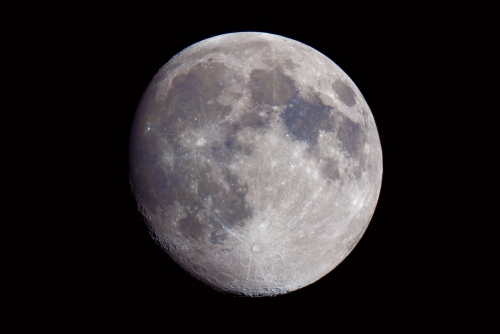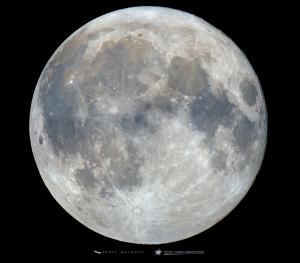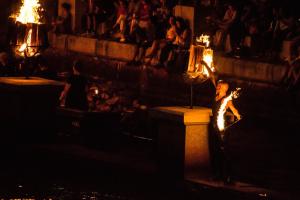
Stargazing Nights - Eve of Autumnal Equinox
- Where:
- Frosty Drew Observatory
- When:
- Friday September 21, 2018 at 7:30 p.m
- Cost:
- $5 Suggested Donation per person 5 years and older
Tonight is Stargazing Night at Frosty Drew Observatory and forecasts are calling for increasing clouds shortly after sunset, eventually becoming fully overcast in the morning hours before sunrise. Timings put our stargazing geek out under partly cloudy skies. Being that we have a 90% waxing gibbous Moon with us until 2:50 a.m., we should be able to score a view in between passing clouds and through thin cloud cover. The wind on the other hand, which will be gusting into the 35mph range, could likely restrict our viewing to only one side of the sky. We will take the night as it goes and see what happens.
The Observatory and Sky Theatre will open at 7:30 tonight. In the Observatory, telescopes will start off with views of Jupiter and the four Galilean Moons if wind permits. Saturn, Mars, and the bright gibbous Moon will be the primary focus of the night, and wind will play a big part in that selection. Though bright, the 90% waxing gibbous Moon is a fabulous phase for observing notable craters and the rigorous lunar terrain; showing off Copernicus Crater, Tycho Crater, Plato Crater, Sinus Iridum and more. In the Sky Theatre we will show our popular feature of celestial objects photographed at Frosty Drew Observatory. We’ll stay open until 11:30 p.m. or until clouds or wind chase us out, no earlier than 10:00 p.m. Check in on our Twitter (@FrostyDrewOBSY) or on the right column of our website for updates on what we are seeing at the Observatory.
Overall, tonight’s increasing clouds will eventually overcast our view. But this will likely not happen until after we pack up the night. If making the long drive, it’s a risky night, though favorable for views of the Moon and planets. The brightness of the coming Harvest Moon on Monday will obscure any chance of observing the Milky Way or the amazing starscape over Frosty Drew Observatory, leaving the planets and the Moon set up for excellent viewing! Winds will be gusty and may restrict our viewing to only one side of the sky, though the Moon, Mars, and Saturn should all be accessible. Clouds are the only variable, which will likely be manageable in the earlier part of the night, becoming heavier as we come to a close. So celebrate the coming autumnal Equinox tomorrow with a night out under the stars tonight.
-----------------------
Weekly Happenings
Scott MacNeill
Tomorrow night, at 9:54 p.m. EDT (September 22, 2018), Earth will reach the point in our orbit around the Sun where we are neither tilted towards nor away from the Sun. This is the Autumnal Equinox, which marks the first day of autumn in the Northern Hemisphere. Earth is tilted 23.4° on its axis, and depending on where Earth is in our orbit around the Sun, will determine if that tilt is towards the Sun or away from the Sun. This is what gives Earth its seasons. On the Summer Solstice, Earth reaches maximum tilt (23.4°) towards the Sun, skip ahead six months and we have the Winter Solstice, when Earth reaches maximum tilt (23.4°) away from the Sun. March and September bring the equinoxes, when Earth’s axial tilt is neither toward nor away from the Sun. On these two days (including tomorrow), all locations on Earth will experience an equal amount of daytime and nighttime. If you stand at the North Pole or South Pole, the Sun would ride the horizon all day. After the Autumnal Equinox, nighttime periods become longer than daytime periods on a daily basis in the Northern Hemisphere. So celebrate the start of Autumn and all the pumpkin eating, leaf-peeping craziness that comes with our decent into the darker side of the year, and have a Happy Autumnal Equinox from all the astro geeks at Frosty Drew Observatory!
This coming Monday, September 24, 2018 at 10:52p.m. EDT, the Harvest Moon will occur. Commonly, and somewhat mistakenly, the Harvest Moon is generally accepted as the name of the September Full Moon. Though the September Full Moon carries the name “The Full Corn Moon”. The Harvest Moon is actually a moniker the is applied to the Full Moon that occurs closest to the Autumnal Equinox, and is usually the September Full Moon, though at times coincides with the October Full Moon; which happened in 2017. Another commonly accepted belief is that the Harvest Moon is the brightest and largest of all Full Moons, which is also just a myth. The Harvest Moon, on average, is no larger or brighter than any other Full Moon of the year. Though you have seen so many pics that exaggerate the size of the Moon (like this, and this, and this, and this), which are either false, or captured from a great distance (in regards to terrestrial objects in the photo) using a telephoto lens. Add in all the stories we have heard about harvesting crops to the brightness of the Harvest Moon, that we have formed untrustworthy memories of seeing that massive-intense-blinding-blazing-monster Harvest Moon. Even as you read this you’re probably thinking “but I remember, for sure, seeing that crazy bright, huge Harvest Moon?!” The Harvest Moon happens during harvest, and being a Full Moon, it is bright enough to work by the light of, and hails the coming of one of our favorite times of the year, autumn. So step out Monday night and catch a sight of the Harvest Moon, and if it looks amazingly humongous, extend your pinky finger out at arms length in front of the Moon, and it will cover the Moon, the same way it does during any other Full Moon.
Save the Date:
Saturday, September 22, 2018 will bring a full lighting of Waterfire in Providence, RI. Each Waterfire event has a theme and this weekend’s theme is a salute to Rhode Island educators and science! Starting at 3:00 p.m. Frosty Drew Observatory’s, Scott MacNeill will join up with Brown University in setting up telescopes and astronomy presentations in Market Square and along River Walk. All this is happening alongside dozens of fabulous science showcases and demonstrations, compliments of Brown University and Computer Science for Rhode Island. It’s also worth mentioning that Waterfire is an amazing event in itself, made up of dozens of fire blazing braziers along the rivers of Providence, accompanied by music, food, fire dancers, artists, street performers, and more. It’s certainly one of the amazing things happening in Providence, RI. So stop in between 3:00 p.m. - midnight and celebrate the first night of autumn with smoke and music, and catch a view of Saturn’s rings, Mars’ southern polar ice cap, the near Harvest Moon, and so much more in Providence tomorrow night.
-Scott



